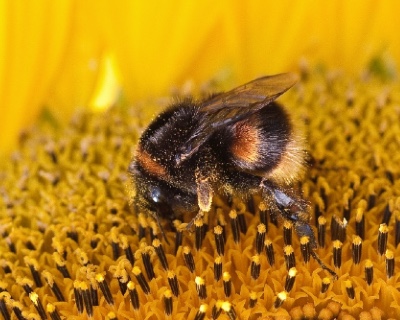Help grow a million bumblebee miles
By working together across the country, gardeners can grow enough flowers to power these precious pollinators to the moon and back!
Scientists have shown that gardens are important sources of nectar, the sugar-rich energy source pollinators need – and on average 85% of nectar in cities is produced in gardens. What's more, small gardens can be every bit as good as large ones when it comes to providing food for hungry bees.
To get everyone involved, Helen and the pollinator team at RHS Science have designed three planters – and they're not just good for bees, they are great for people too!
Helen says: “Chives flower in late spring, and bumblebees with their relatively long tongues can easily probe into them for the sugar-rich nectar. Remember when snipping chives for salads not to cut off the stems with flower buds.”
Wild marjoram, Origanum vulgare, is a useful culinary herb that's great on a pizza. Sometimes also referred to as oregano, it blooms for months on end in summer and early autumn, and the pink flowers are loved by all kinds of pollinating insects. Phacelia is a quick-growing annual plant: sow seeds in spring and by midsummer you'll have a haze of blue-violet flowers, buzzing with bumblebees. Or for a similarly high-nectar-producing
Helen says: “For sheer number of flowers, you can’t beat marjoram with an estimated 250-500 flowers per plant. This means a huge hit of nectar for pollinators. Rub the lovely aromatic edible flowers and foliage to smell the relaxing scent of summer.”
There are many, many varieties of cosmos, Cosmos bipinnatus, available. Tall or short and in a range of colours from pure white through pinks to reds and yellows. You can sow them directly into the soil in late spring, or buy ready-grown plants to plant out. Just be sure to pick a single-flowered variety, as these contain more pollen and nectar. If you can see the yellow pollen-filled centres of the flowers, you know the bees will enjoy them too.
Helen says: “An average snapdragon plant can fuel a bumblebee for 10-13 miles a day. Watch closely to see how the bumblebee has to push hard to open the flower to get to the valuable nectar inside, getting coated in pollen as it is temporarily ‘eaten’ by the flower!”
Calculations in this article are from several recent pieces of pollinator research, including:
- Quantifying nectar production by flowering plants in urban and rural landscapes (Tew et al., 2021)
- Turnover in floral composition explains species diversity and temporal stability in the nectar supply of urban residential gardens by Tew, N.E. et al. in Journal of Applied Ecology.



